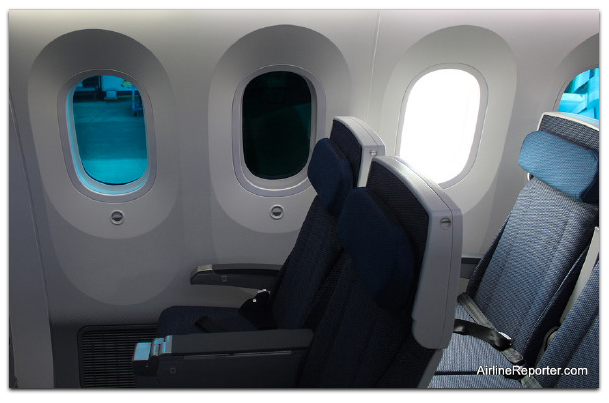Crew vs. View on United’s Boeing 787

I’ve been wanting to fly on the Boeing 787 “Dreamliner” ever since I missed a chance to go on an inaugural junket aboard one before Boeing began delivery to the airlines. But I finally got my chance last week, aboard United Flight 935 from London to Los Angeles.
Some context: I actually like United, and have had none of the bad experiences people tend to associate with big old airlines, and plenty of good ones. Also, not all the news about United is bad. For example, wider economy seats are coming in refurbed 767s.
United is also my default airline by virtue of having flown 1.5 million miles with them. This has earned me some status. Specifically, I get on shorter lines, don’t get charged for bags, and have some choice about where I sit, which defaults to Economy Plus: the section of Economy that features a bit more leg room and is typically located behind business/first, which United now call Polaris.
Okay, who how was that new 787?
On the plus side, it’s a nice plane in many ways, as Boeing explains here. Maybe the best in the air today.
On the minus side, my experience was less than ideal, none of it the fault of the plane itself (specifically, the Boeing 787/9.)
First, the whole Economy Plus section is over the wing on both United’s 787/8 and 787/9. (Source: SeatGuru.) This means there is little or no view of the ground out the windows of that section. Seeing the ground is one of the main attractions of window seats and why I love flying. See all these photos were taken out the windows of planes? Nearly all the planes I shot those from were United’s, and I have kindly tagged them #United as well. (See http://bit.ly/UnitedAerial.)
To be fair, all of United’s widebody planes (747,767, 777, 787) put most of Economy Plus over the wing. But in most cases a row or two of Economy Plu is in front of the wing or behind it. Not, alas, on the new 787s. See here:

So I booked a seat in the economy section. Fortunately, I don’t have long femurs, so leg room usually isn’t an issue for me. In fact, I like sitting in the back of a passenger plane, the farther the better. That way as little of the wing as possible intrudes on the view. And the legroom actually wasn’t bad on this plane anyway, so that’s one plus.
The seat I chose was 37L, a window seat in a row that gave me 3 seats to myself, because the flight turned out to be less than full. This is another reason to book seats in the back. They’re the least likely seats to be filled on a less-than-full flight. (But be sure to check with SeatGuru, which warn me away from rows which have missing windows. Most planes do have some of those.)
My second problem turns out to be one of the 787’s biggest selling points: electronically dimmable windows:

It’s a clever system that eliminates the window shade, an ancient feature that actually gives the individual a simple manual control over the view, and of light coming in.
My problem wasn’t with the windows themselves, which are relatively large (but with the added view toward the sky rather than the ground). It was with the loss of individual control, and an apparent preference by the crew for the equivalent of no windows at all.
See, on this flight the crew turned all the windows dark just before the fjords and glaciers of Greenland’s coast came into view. They announced that this was so people could sleep or watch their screens without glare. But this flight wasn’t a red-eye. The plane left at roughly 2pm from London and arrived in Los Angeles at around 5pm, with daylight all the way. Yes, it would be the middle of the night (UK time) on arrival, but that was another six hours in the future, and the scene was amazing:

So I turned my window up to clear (which happens so slowly you wonder if it’s working at first), and a flight attendant came over. Here’s the dialog, as best I recall it:
“Sir, you need to darken your window.”
“I got a window seat so I could see outside.”
“But other people are trying to sleep or watch their screens.”
“I’ll darken it later. Right now I want to see Greenland. Have you seen this? It’s spectacular.”
“Please be aware of the other passengers, sir.”
In fact I was.
There were two empty seats in my row.The window seat wasn’t occupied in the row in front of me. (An older woman seemed to be sleeping in the middle seat.) And the only other passenger in sight was a guy reading in an otherwise empty middle row across the aisle from me. I was also talking geography with the people behind me, who were watching Greenland scroll by through my aft window (their row, 38, had no window) saying “Holy shit! Look at that! Look at THAT!” over and over. And with good reason. A United pilot once announced to a plane I was on that Greenland is the most spectacular thing one can see from a passenger jet.
So I really didn’t need to dim my window for others. But I felt like I was getting busted for some infraction of flight etiquette that made no sense, given that the 787, more than other planes was supposed to be about the joy of flying. (Louis CK enlarges on this kind of aviation irony with his “Everything is a amazing and nobody’s happy” bit. If you’re in a hurry, start about 2 minutes in.)
It was also strange to have my window darkened by some crew member seemingly every time I looked away from it for more than a couple of minutes. Turns out a feature of the 787 is that the crew can control the “state” of every passenger window on the plane. While that’s cool in some ways, it’s a loss of agency for passengers who still like to look out windows.
My final problem was also with the windows: they block GPS signals, I suppose this is a secondary effect of the dimmable thing. But it meant I couldn’t record the trip on my little Garmin pocket GPS, which I’ve been using for many years to keep track of where I’ve been, and to geo-locate photos.
So, hate to say, I’ll try to avoid United’s 787s from now on, even as I appreciate how well United is keeping their fleet modern. They’re great planes, but not for me.
Originally published at blogs.harvard.edu on September 16, 2017.
